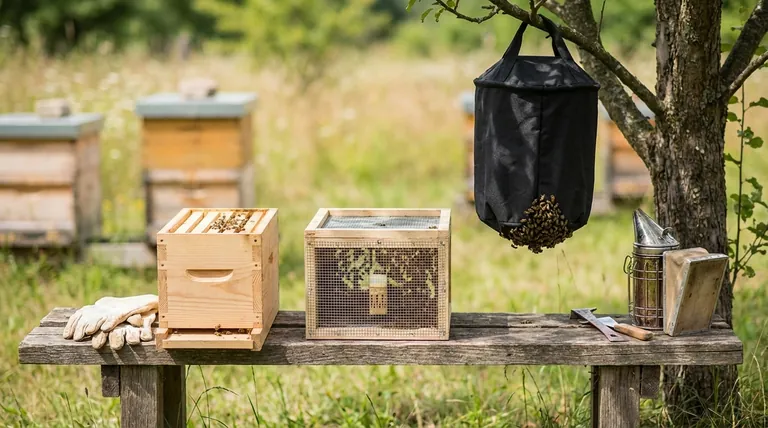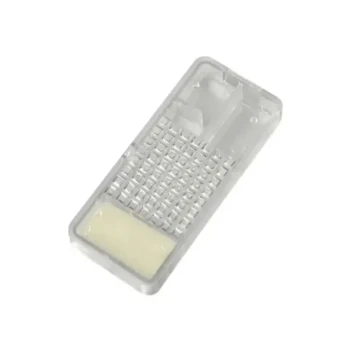To acquire honeybees, you have three primary options. You can purchase a pre-established nucleus colony (nuc), buy a package of bees with a queen, or you can capture a wild swarm or perform a colony removal.
The choice between buying bees or capturing them is a fundamental decision for any beekeeper. It represents a trade-off between control and cost, with your ideal path depending entirely on your goals, experience level, and risk tolerance.

The Three Paths to Starting a Colony
Each method of obtaining bees offers a distinct starting point for your apiary. Understanding the composition of what you are getting is the first step in making an informed decision.
Option 1: The Nucleus Colony (Nuc)
A nucleus colony, or "nuc," is a small, functioning beehive. It is essentially a miniature version of a full-sized colony, ready for transfer into your larger hive equipment.
A nuc typically contains four or five frames of drawn comb, a laying queen who is already accepted by the colony, and bees of all ages. You will find brood (eggs, larvae, and pupae), pollen, and honey stores already present on the frames.
Option 2: The Bee Package
A bee package is fundamentally different from a nuc. It is a screened box containing a specific weight of bees, typically two or three pounds, and a separate, caged queen.
There is no comb, no brood, and no food stores. You are receiving the two essential components—bees and a queen—but they must build their entire colony from scratch in your equipment. The queen needs to be introduced and accepted by the bees after installation.
Option 3: The Feral Swarm or Removal
Capturing a swarm involves collecting a group of bees that has recently left its parent colony to find a new home. A removal involves extracting an established colony from an unwanted location, like the wall of a building.
This method provides you with free bees that are often locally adapted. However, the queen's age and genetic background are completely unknown, and they may come with pre-existing pests or diseases.
Understanding the Trade-offs
Choosing a method is not just about preference; it's about weighing the distinct advantages and disadvantages of each. Your success, especially in the first year, can be heavily influenced by this decision.
Speed of Establishment
A nuc gives you a significant head start. Because it arrives with a laying queen, brood, and drawn comb, the colony can expand its population very rapidly. This is the fastest path to a strong, productive hive.
A package starts much slower. The bees must first build comb, a highly resource-intensive task. Only after comb is drawn can the queen begin laying eggs, delaying population growth by several weeks compared to a nuc.
A swarm is highly variable. A large, early-season swarm can build up extremely quickly, while a smaller, later-season swarm may struggle to establish itself before winter.
Health and Genetics
With nucs and packages, you are purchasing from a supplier. This allows you to select for specific genetic traits, such as gentleness or mite resistance, and you have a reasonable expectation that the bees have been inspected for disease.
With a swarm, you have no information. The bees could be gentle or aggressive, productive or weak. They could also be carrying a high load of varroa mites or other pathogens from their parent colony.
Cost and Availability
Swarms are free, but their availability is unpredictable and dependent on season and location. Capturing one requires having equipment ready at a moment's notice.
A package is generally the least expensive purchasing option. It is a straightforward way to acquire bees for a lower initial cash outlay.
A nuc is the most expensive option. You are paying a premium for the drawn comb, established brood pattern, and the significant head start it provides your colony.
Making the Right Choice for Your Apiary
Ultimately, your goal dictates the best method. Consider what you want to achieve in your first season and what level of challenge you are prepared to accept.
- If your primary focus is a fast, reliable start: A nucleus colony is the superior choice, as it minimizes initial risk and accelerates colony development.
- If your primary focus is a lower-cost but controlled beginning: A bee package allows you to start a hive with known genetics for less money than a nuc.
- If your primary focus is a free, natural, and challenging experience: Capturing a local swarm is an excellent option, provided you are prepared for the unknowns.
Choosing how to begin your apiary is the first critical step in your beekeeping journey.
Summary Table:
| Method | Key Features | Best For |
|---|---|---|
| Nucleus Colony (Nuc) | Miniature hive with frames, brood, & a laying queen | Fast, reliable start; lower risk |
| Bee Package | Bees + caged queen; no comb or brood | Lower-cost beginning with controlled genetics |
| Feral Swarm/Removal | Free, locally adapted bees; unknown genetics | Experienced beekeepers seeking a challenge |
Ready to equip your new colony? The right start is crucial, and so is having the proper equipment. HONESTBEE supplies commercial apiaries and beekeeping equipment distributors with high-quality, durable beekeeping supplies through our wholesale-focused operations. Let us help you build a strong foundation for your beekeeping success. Contact our experts today to discuss your needs!
Visual Guide

Related Products
- HONESTBEE Collapsible Tiered Bee Swarm Catcher for Beekeeping
- HONESTBEE Professional Telescopic Pole Bee Swarm Catcher
- Twin Queen Styrofoam Honey Bee Nucs Mating and Breeding Box
- Portable Bee Mating Hive Boxes Mini Mating Nucs 8 Frames for Queen Rearing
- Black Plastic Beetle Barn Hive Beetle Trap for Beehives
People Also Ask
- What is the typical method for moving a swarm of bees? Capture the Queen for a Safe & Easy Transfer
- What do beekeepers use to attract bees? Master Swarm Capture & Hive Management
- How to attract bees to a hive box? Proven Methods for Swarm Capture & Colony Expansion
- What information should be gathered before attempting to catch a swarm of bees? A Safe and Successful Guide
- Can a nuc box be used for swarm catching? An Effective and Manageable Solution for Beekeepers



















